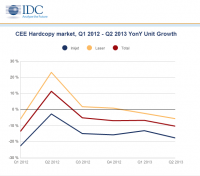 Weakening demand leads to 10.3 percent year-on-year decline during the second quarter.
Weakening demand leads to 10.3 percent year-on-year decline during the second quarter.
IDC research found that the Central and Eastern European (CEE) hardcopy peripherals (HCP) market continued to decline in 2Q13, with shipments falling to just over 1,696,000 units amid weakening demand among consumers.
Mitri Roufka, Research Manager for imaging, printing and document solutions in the CEMA region at IDC, explained that the weakening demand was “due to the region’s struggling economies and high unemployment rates”. He added: “On top of the limited disposable income of consumers, printing at home remains a low priority requirement” in the region.
Early recessionary signs in Russia, CEE’s biggest market, were said to account for much of the decline, with Roufka explaining that “a fall in investments and in demand for raw materials saw Russia’s GDP growth forecast for 2Q13 slashed by half a percentage point […] and if it were not for the 14.3 percent year-on-year fall in Russian shipments, the market for laser HCPs in CEE would have recorded only a moderate decline [of] around six percent”.
Demand for inkjet devices in the past was reportedly inflated by “bundled deals”, bought to an end by “vendors’ efforts to replace their inkjet lines with higher-value devices that use less expensive consumables”. Roufka said that “as a result, a more realistic picture of demand is emerging […] inkjet vendors are increasingly targeting small and medium-sized businesses with these new devices”, with these businesses accounting for “almost 76 percent of all pages produced in the home/office segment”.
HCP vendors, on the other hand, saw good news in that business demand, particularly for laser devices, remained strong in most CEE markets. Roufka explained that this is due to printing being a “core need” for businesses, which are the main buyers of laser devices; and they continue to refresh their printing fleets. He added: “The small decline (3.8 percent) of laser shipments in the first half of 2013 (and mainly because of Russia) is indicative only of broader economic difficulties, inevitably a significant factor in determining businesses’ IT investments.
“This also refutes popular theories that ‘printing is dying’ or that a ‘dramatic impact of tablets on the printing industry’ is imminent, or even advice to laser HCP vendors that they had better start thinking about more profitable businesses like document destruction or delivering water instead of selling toner.”
Competition between laser manufacturers however continues to intensify as end-users increasingly look to reduce printing costs by “eliminating inefficiencies, replacing single-function and lower-speed devices with MFPs and/or faster devices with lower TCO, streamlining workflow and document processes to reduce page counts, or shifting to third-party (non-original) consumables”.
The issue of consumers forgoing printer ownership in favour of printing in the workplace, with Roufka commenting: “We do think that some home users are shifting their personal, sporadic printing from home to the workplace […] a trend which particularly cash-strapped businesses may want to keep a close eye on.”
